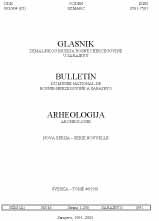Kasnoantičko utvrđenje na lokalitetu Gradac na Ilinjači u Gornjem Kotorcu kod Sarajeva
A late antique fortification at the location of Gradac on mount Ilinjača of Gornji Kotorac near Sarajevo
Author(s): Lidija FekežaSubject(s): Archaeology
Published by: Zemaljski muzej Bosne i Hercegovine
Summary/Abstract: The paper deals with mobile material found at the late Antique fortification of Gradac on mount Ilinjača. A church built probably in the fifth century was located within the fortification walls. The fortification constructed around the middle of the sixth century, during the Justinian epoch, is located on the edge of slopes surrounding Sarajevsko Polje, as well as the neighbouring fortification of Debelo Brdo from which smaller objects were analysed as comparative material. Mobile archaeological material was excavated at both the fortifications from surface layers of rubble mixed with prehistoric remnants. There are no vertical layers, however, and even the horizontal stratigraphy did not contribute much to the solution of certain problems. The analysed material contained fragments of ceramics and glass as well a metal objects. The ceramic material was divided into two basic groups: provincial – Roman ceramics from the third and the fourth century, dark and soft structures and typical ceramics from that period, hard structures. The latter also contained fragments with early – Byzantine reflection. The domestic coarse is well – known from numerous late – Classical localities m Bosnia and Herzegovina. There is a dilemma present at attribution of ceramics with dark and soft structure – whether it dates back to late – Classical or early-Slovenian period. Fragments of glass vessels with thickened rims, sloping sides and convex bottoms are also frequently to be found at the above localities dating back from the fourth to the sixth century. Metal objects also do not stand out from the general pattern of findings of the same period, but the author has separated some findings more precisely dated to originate from the second half of the sixth century, i. e. fibulae with a bent leg, clasps of the Mediterranean type, scales and belt pins. These findings have confirmed that the fortifications have been correctly dated. All the material belongs to the old-settlers romanized population converted to Christianity. Most probably some of the excavated objects were manufactured in the production centres of Salona.
Journal: Glasnik Zemaljskog muzeja Bosne i Hercegovine u Sarajevu: Arheologija
- Issue Year: 2005
- Issue No: 46
- Page Range: 175-202
- Page Count: 28
- Language: Bosnian

